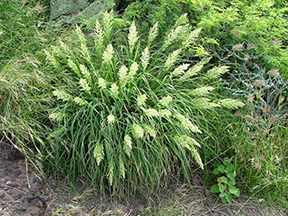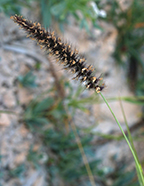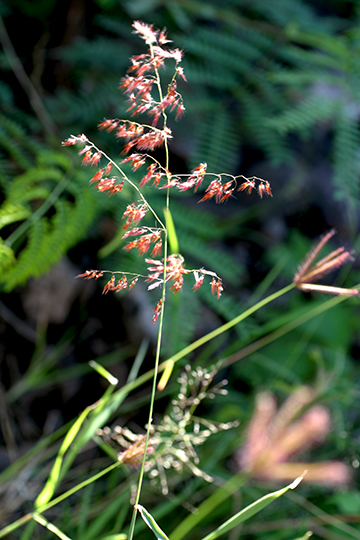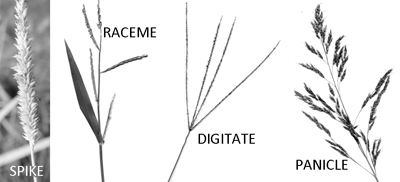|
|
||||||
 |
CPIE MultiAccess Key (MAK):
Herbaceous Plants of Hawai‘i & Guam – GRASSESto MAK homepage.
|
` 
|

|
|||
|
|
||||||
|
This multiaccess key is for identifying a plant likely to be a true grass (monocot Family Poaceae). The data base (DB) "MAK_1" presently contains 159 taxa covering grasses, sedges, rushes, and cattails, of which 109 taxa are grasses known from Hawai‘i and 53 taxa are grasses known from the Marianas. Estimated total grass taxa occuring in Hawai‘i is ~180; for Guam, this number is ~130. The following list of character choices applies specifically to true grasses only. A separate MAK sedge key is available for sedges, rushes, and cattails. To limit results to grasses known from the Marianas Archipelago, use the check box above the SUBMIT buttom at the bottom.
Terms used in this key are defined in column 2 below. However, should you need to gain greater familiarity with the terminology used for grasses, consult the companion dichotomous key: Grasses, Sedges & Rushes of the Hawaiian Islands and Guam, page iv on grass plant structure or page v on grass flower characteristics. Careful examination of the flower structure under magnification may be necessary to positively identify most grasses and the MAK key includes species-specific links to appropriate couplets in the CPIE dichotomous key: A Key to the Grasses, Sedges, & Rushes of the Hawaiian Islands and A Key to the Grasses, Sedges, and Rushes of the Island of Guam.. In other cases, a reference source is provided that may be consulted for a more detailed description or a picture (drawing or photograph) of the species. A useful resource of photographs of grass spikelet details is found in Key to Hawaiian grasses ver. 1.0 (PDF) posted by Kevin Faccenda at UH Manoa |
DATABASE: MAK_1 for POACEAE ~ TOTAL DB LINES: 159 GRASSES, SEDGES, RUSHES
MATCHED: 0
REJECTED: 0
|
||||||
|
CHARACTER MATCH LIST
|
|
||||||
|
Species - Common Name
|
Status
|
Reference
|
|||||
|
Select plant characteristics from far left column. == Results will appear here == | |||||||
|
|
HABIT: In a "clumping" grass, individual plants are not connected above ground by stolons; in a "spreading" grass, plantlets are formed along runners and may form a turf (lawn). Selecting wetland HABITAT (growing in or near water) will restrict the list to only FACW and OBL wetland plants. SIZE: "small" grasses are ankle to shin high, "medium" grass plants are knee to waist high; "large" grass plants are chest high to over your head; "very large" grass plants approach or exceed 3 m (10 ft) in height (see also Basic Grass Characteristics).
VEGETATIVE PARTS is for notable characteristics of the grass excluding the inflorescene. LEAF SHAPE is a somewhat imprecise characteristics that differentiates between long narrow leaves with the margins "parallel" for most of their length or "boat-shaped": leaves becoming broadest near the middle and tapering towards the tip. The leaf tip can be "acute" (coming to a sharp point) or "blunt" (more or less rounded). A leaf is "especially narrow" if the width is under 2 mm (~1/10 in): is needle or thread-like. LIGULE: The ligule is a small linear structure located inside the leaf collar (bottom of blade) up against the culm (see Fig. 1A at Basic Grass Characteristics). If the leaf is small, this feature can be difficult to see without magnification, but is a useful vegetative character. INFLORESCENCE: The form of the inflorescence or flowering head is a critical characteristic used to identify the genus of a grass specimen. Details of inflorescence shape can be reviewed at Basic Grass Inflorescence Characteristics) and refer to the figure below right on this page. As used here, a spike is an arrangment of the spikelets around a single rachis (main axis above the culm)—score foxtails here as "spike-like", although in some, short branches are arranged in whorls around a central axis. A simple raceme has spikelets on two or more branches coming off the rachis. Three or more branches coming off the culm at or near a single point form a digitate (finger-like) raceme. Branching that is complex is termed paniclulate, or multi-culmed if multiple flowering branches arise off upper culm nodes. A "plumose" inflorescence is one with (usually white or pink and conspicuous) hairy spikelets (for example, sugar cane). SPIKELET: The tiny flowers of a grass are called florets. A floret has the basic reproductive parts (ovary and anthers) enclosed within surrounding bracts. The reproductive parts are pretty much the same for all grasses, but the surrounding bracts (including their presence or absence) hold important characteristics to identification of a species. The floret and its floral bracts and (usually) paired lower-most bracts called glumes form the spikelet. The bracts are quite small and observing them usually requires magnification. Included here are basic characteristics that could be observed in the field with a simple hand lens or loop. AWNS: The small bracts surrounding each floret may be awned. Also included here are conspicuous bristles that macroscopically give the impression of awns. An awn shorter than its bract is counted as absent or tiny. |
NOTES: INSTRUCTIONS: Select a best choice from each of the categories in the far left column. Do not make a selection in any category that you do not know if it applies to your specimen. If more than one choice applies in a category, it is usually better to choose the lower one. However, you can CLEAR and try different combinations; and it is better to CLEAR before submitting a new combination of properties, although will usually work fine if you do not. Understand that the TERMINOLOGY used in this key—as defined in the column to the left and on introductory pages to our A Key to Grasses and Sedges of the Hawaiian Islands—may not always match exactly that used by grass specialists, having been adapted here to make this key friendlier to the casual user. The key only considers those species of grasses in the data base (MAK_1), the stats of which will appear in the blue box above once a search has been implemented. The data base is regularly added to, but rare grass species are not included in order to reduce the number of "hits" provided.CONFIRMING AN IDENTIFICATION will require careful consideration of the species description provided in the reference link or some other source (see MAK Useful Links and the grass key Bibliography page for suggestions). An active link presented in the Reference column will open on the relevent couplet in the dichotmous key: A Key to Grasses and Sedges of the Hawaiian Islands & Guam, providing descriptive information on that species. Additional details can be gleaned by "backing off" the couplet (a process of following links backwards from the terminal couplet). "MAN" in this column refers to Vol 2 of Manual of the Flowering Plants of Hawai‘i. "[fig]" indicates a photo or drawing available in the linked reference source.
|
|
|
|||
